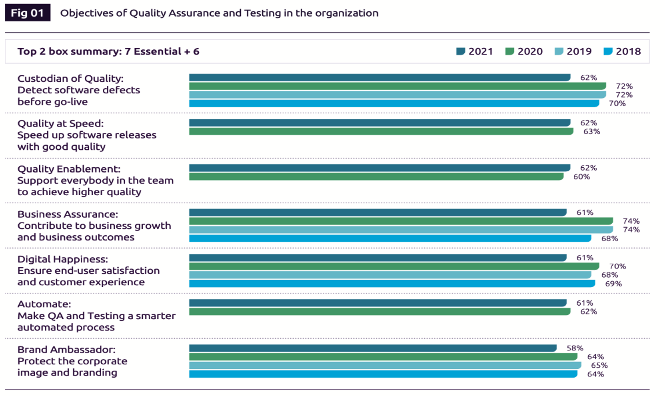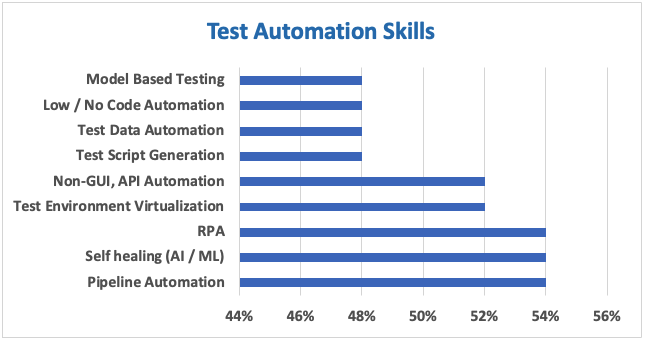
AI is Transforming Test Automation

What’s better than detecting and correcting errors during quality assurance? Preventing them from happening in the first place!
The last few years have ushered in a new era of quality assurance (QA) protocols, specifically in the testing arena. Test automation has minimized repetition and improved business output, but there are still gaps in the human-bot workflows. Plugging those gaps with artificial intelligence (AI) has proven to be quite successful. AI helps testers not only identify defects, but also analyze them and support preventive measures to avoid them from occurring in the future. Error-free software development is possible and even obligatory as pressure for high quality technology mounts. Let’s zoom in on test automation and how AI can deliver the competitive advantage you need to satisfy your team and customers.
Quality Assurance Demands are on the Rise
QA, a subset of quality engineering, was originally seen as only a process of defect identification. Now, it is regarded as a structured procedure to improve the quality of delivery and provide an enhanced user experience. A survey conducted over four years assessed upper management’s feelings towards QA objectives and how the quality landscape has progressed over time in the strategic arena.

(Source: World Quality Report 2021-22)
The insights of the survey revealed that detecting defects was consistently seen as the primary objective of QA by managers. However, 63% of those surveyed also associated QA with customer experience, 62% with speed, and 61% with high responsiveness to business demands. With these proclamations, QA teams can be seen not only as the custodians of quality but also its champions!
Introducing Automation to the Testing Process
When Covid-19 began tightening its grip on society, life as we knew it changed forever—the software development industry was no exception. Manual IT procedures like testing became challenging with knowledge workers spread around the country and even the globe. Corporations were quick to evolve to the changing dynamics and pivoted on-prem testing to remote. While automation was already prevalent in QA testing prior to the pandemic, it became much more mainstream. It has been especially useful for continuous integration and continuous delivery. Automating these repetitive, time-consuming tasks that were previously carried out by manual testers helps speed up the process, reduce errors, and free up knowledge workers to focus on more critical work.
While test automation enables improvements in speed and capabilities, it also presents challenges. Testing stability, for instance, is affected by elemental changes in native applications. This happens because automation test scripts can’t automatically adapt to changes. The results could be data inconsistencies, test failures, and even build failures. Expanding ranges of testing scenarios, extensive updates, and ongoing modifications are also problematic when trying to automate testing. Moreover, preparing the testing environment and integrating it with the development is still tedious with test automation.
Meanwhile, society’s reliance on technology and customer expectations for software were skyrocketing as the pandemic persisted, increasing the demand for working capital and human resources. Among those expectations are:
- Greater ROI
- Better detection of defects
- Reduction in test cycle time
- Test coverage
- Control and transparency of test activities
Human resources in the QA space are distributed between manual and automated testing procedures. Automation is used for only 15-20% of tests that included regression, acceptance, and test data generation. However, expanding a resource pool to meet the needs of changing dynamics can be capital intensive, time-consuming, and risky. With finite resources, it’s clear to see traditional test automation alone can no longer scale to meet the growing demand for automation skills in software development.

(Source: World Quality Report 2021-22)
An alternative is to reduce the need for scripting skills so that development projects could be completed with limited resources. That’s where the innovative approach known as intelligent automation comes in. Intelligent automation combines automation with cognitive technologies like AI, machine learning, and computer visioning to create end-to-end business processes that think, learn, and adapt on their own.
AI to Empower Test Automation
When it comes to test automation, AI presents a unique opportunity to further digital transformation and achieve never-before-reached levels of productivity and efficiency throughout the QA cycle. AI can identify, learn about, and adjust to key script changes in real time to create a more sustainable and consistent test environment. While human involvement is still required in software testing, AI can take over tasks that do not require complex decisions to make the testing process faster, easier, and more efficient. Graduating from defect detection to defect prevention is also possible with artificial intelligence.
The integration of AI with test automation can change the way test procedures are perceived, developed, and executed. For a tester, this would mean a time savings of 30% that goes into data maintenance. For a customer, it would mean the product landing on their doorstep faster and with higher quality. For a business, it would reduce the development cost and time, as well as increase revenues and customer satisfaction levels. Below are some additional qualities of AI in the QA arena:
- AI adds capabilities like self-healing to stabilize test automation and speed up maintenance
- Symbolic AI is used for reviewing codes to ensure they follow the best practices
- Machine learning (ML) visual validations in AI-based UI-testing could help identify differences that might go unnoticed by human testers.
- Smart AI assistants enable precision testing facilitated by lessons from fingerprinting of test case failures
- AI tools crawl web applications to train ML models with pattern deviations and bugs identify and understand by exploring a wider knowledge base
- AI can leverage image-based learning to test the look and feel of a mobile or web application
Although the technology as it applies to QA is still maturing, organizations have already realized improvements in their QA processes with AI. Supplementing automated testing with AI has helped enterprises achieve:
- Flexibility in testing automation
- Early detection of problems or defects
- Faster time to market
- Exploratory testing for user interface with expanded code coverage
- Reduced downtime and boost efficiency
- Automated test units to generate code for quick testing
- Business growth
- Higher customer satisfaction
AI-Powered Predictive and Prescriptive QA with Apexon
AI has already redefined the technological landscape and shows no signs of stopping. We at Apexon resolve to harness the power of AI in test automation procedures to do the following:
- Simplify testing procedures –
- Defect clustering helps in the prioritization of test cases
- Script-less automation and self-healing supports the maintenance of automation scripts
- Analytics that help in defining the scope of testing, define quality, and how to conduct test routines
- Improve the quality of software
- Intelligent use of AI improves the overall quality of testing procedures
- AI integration with QA helps in understanding failures and identifying corrective actions
- Add new capabilities to testing
- AI is used to remove redundancy in test cases, predict defects in test models, and prioritize test cases based on risks.
With the current demands of agile development, neither organizations nor customers can afford to accept error-ridden sprints. Augmenting the test automation with AI is proven to save time, increase accuracy, and assist testers in delivering exceptional digital products. The QA landscape is changing, are you ready? Submit the form below and we will reach out!
Sources: The images and facts mentioned in this article are taken from the World Quality Report 2021-22
Link: https://content.microfocus.com/world-quality-report-tb/world-quality-report-2021-22




